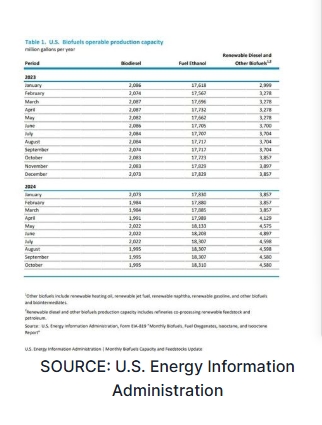
Total biofuel capacity reached 24.885 billion gallons per year in October 2024, up 3 MMgy when compared to the previous month and 1.222 billion gallons per year when compared to October 2023.
Ethanol capacity reached 18.31 billion gallons in October, up 3 MMgy when compared to September and up 587 MMgy from October of the previous year.
Biodiesel capacity was at 1.995 billion gallons in October, unchanged from the previous month, but down 88 MMgy when compared to October 2023.
Capacity for renewable diesel and associated fuels, including renewable heating oil, renewable jet fuel, renewable naphtha, renewable gasoline and other biofuels and biointermediates, was at 4.58 billion gallons in October, unchanged from the previous month but up 723 MMgy when compared to October of the previous year.
Total feedstock consumption reached 29.713 billion pounds in October, up from 28.056 billion pounds the previous month and 28.833 billion pounds in October 2023.
U.S. biofuel producers consumed 26.133 billion pounds of corn in October, up from 25.049 billion pounds in September, but down from 25.775 billion pounds in October 2023. Grain sorghum consumption was at 195 million pounds in October, up from 110 pounds the previous month and 116 million pounds in October of the previous year.
Biofuel producers consumed 1.227 billion pounds of soybean oil in October, with 709 million pounds of that volume consumed by biodiesel producers and 518 million pounds consumed by renewable diesel plants. Soybean oil consumption was at 1.067 billion pounds the previous month, with 376 million pounds going to biodiesel production and 403 million pounds going to renewable diesel production, and at 1.062 billion pounds in October 2023, with 645 million pounds of that volume consumed by biodiesel producers and 417 billion pounds consumed by renewable diesel plants.
Canola oil consumption increased to 454 million pounds in October, with 138 million pounds going to biodiesel production and 316 million pounds consumed by renewable diesel producers. Canola oil consumption at 289 million pounds in September, with 127 million pounds going to biodiesel production and 162 million pounds going to renewable diesel production. Biofuel producers consumed 286 million pounds of canola oil in October 2023, with 165 million pounds of that volume consumed at biodiesel plants and 120 million pounds consumed at renewable diesel facilities.
Corn oil consumption reached 421 million pounds in October, with 65 million pounds of that volume going to biodiesel production and 356 million pounds going to renewable diesel production. Corn oil consumption was at 361 million pounds in September, with 70 million pounds used to produce biodiesel and 291 million pounds consumed at renewable diesel facilities. Corn oil consumption was at 324 million pounds in October 2023, with 76 million pounds consumed by biodiesel plants and 248 million pounds consumed by renewable diesel facilities.
Biofuel producers consumed 604 million pounds of yellow grease, 592 million pounds of tallow, 46 million pounds of white grease, 24 million pounds of poultry fat and 16 million pounds of other fats, oils and greases in October 2024. Consumption was at 587 million pounds, 494 million pounds, 50 million pounds, 25 million pounds and 19 million pounds, respectively, in September, and at 668 million pounds, 450 million pounds, 53 million pounds 15 million pounds and 17 million pounds, respectively in October 2023.
The EIA withheld data on the consumption of several feedstock types in October to avoid disclosure of individual company data, including agriculture and forestry residues, other types of agriculture and forestry residues, other vegetable oils, other types of recycled feeds and wastes and other biofuels feedstocks not elsewhere identified.
Additional data is available on the EIA website.